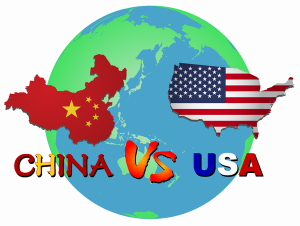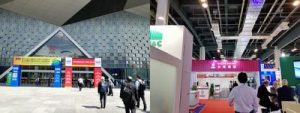The Meteorological Agency declared setting-in of the rainy season of Tokai, Kanto Koshin, Hokuriku, South Tohoku on 7th. At last I feel greatly relieved freeing from unseasonable heat of the temperature of above 25 degree C and 30 degree C in the day of the past one month for a while. When I was young, I waited expectantly for summer.
I felt that a pure white thunderhead of the horizon could give freedom, the energy sprang out, the dream to spread and infinite possibility to me. However, I am beginning to dislike the summer. I don’t know when it start but I could not bear the shinning sun glare and sweat which sprang out even if I wiped over and over again and feeling of languor which comes after. I feel that winter is still easier to spend than summer these days. It is necessary to understand that physical constitution should change according to aging.
The World Bank revised the world economy growth rate that they revised in January downward on June 4. They considered the influence of decrease of trade and investment on world economy by the intensification of the U.S. and China trade friction.
In addition, the following expectation does not include 25% of new additional duties for the Chinese product for 300 billion dollars by the United States.
2019 world economy growth rate expectation by the World Bank
| 2019 | % change | 2020 | % change | |
| World | 2.6 | -0.3 | 2.7 | -0.1 |
| USA | 2.5 | 0.0 | 1.7 | 0.0 |
| Euro Zone | 1.2 | -0.4 | 1.4 | -0.1 |
| Japan | 0.8 | -0.1 | 0.7 | 0.0 |
| China | 6.2 | 0.0 | 6.1 | -0.1 |
| 世界貿易量 | 2.6 | -1.0 | 3.1 | -0.4 |
Note 1) Growth rate (%) compared with the previous year
Note 2) The up and down rate to be based on this January (Jun. vs Jan.)
Shipping Guide quotes the figures that British Container Trades Statistics compiled. The quantity of world container cargo movement of April is 3.2% increase to 14,201,324TEU from a year earlier. 2.6% decrease compared with the month before. According to a main area: export of the Far East is 3.2% increase to 7,794,414TEU from a year earlier. Import is 5.2% increase to 5,452,231TEU. Import of Europe is 8.9% increase to 2,967,651TEU. Export is 8.5% increase to 2,628,429TEU. On the other hand, the import of the North America decreases by 0.1% to 2,356,629TEU, the export decreases by 0.3% to 1,390,914TEU.
According to the May employment statistics of the U.S. Department of Labor, the number of the non-agriculture section employees is 75,000 increase compared with the month before. It is the low level for the first time in three months. The unemployment rate is 3.6%, the same as the last month. A low level since December, 1969 (3.5%). The mean hourly wage is 27.83 dollars which raises 3.1% on year-to year basis. The population of the United States rises 2,360,000 a year including an emigrant. Individual consumption to account for approximately 70% of gross domestic products (GDP) of the United States supports an economic expansion in America. It will historically renew the longest record of the economic expansion period of 121 months this July.
On June 7, President Trump shelved 5% of duty motion to Mexico. The total import sum from Mexico of 2018 is 346,500 million dollars. The second import country next to China. The United States occupies approximately 80% of export for Mexico. Approximately 40% are car-related. On the other hand, the U.S. and China trade friction was filled with problems to be concerned with an intellectual property infringement, the Chinese national strategy including the industrial subsidy and presented an aspect of the prolongation by an exchange of the retaliatory tariff by China.
 In response to the above Japanese, Taiwanese and American companies have been transferring a production base to any place other than China. In addition, the investment in Southeast Asia by the Chinese company increases rapidly. The Philippines moves in the invitation of the Chinese company. A new investment authorization sum from China spreads to a little less than 6 times from January, 2019 to May in comparison with year-over-year basis in Vietnam. The Nikkei Shimbun informs it that even Thailand increased to double in March from January. Apart from the global company leaving China it was revealed that a Chinese company took the lead and moved the production base in Southeast Asia from China.
In response to the above Japanese, Taiwanese and American companies have been transferring a production base to any place other than China. In addition, the investment in Southeast Asia by the Chinese company increases rapidly. The Philippines moves in the invitation of the Chinese company. A new investment authorization sum from China spreads to a little less than 6 times from January, 2019 to May in comparison with year-over-year basis in Vietnam. The Nikkei Shimbun informs it that even Thailand increased to double in March from January. Apart from the global company leaving China it was revealed that a Chinese company took the lead and moved the production base in Southeast Asia from China.
The shipping line has to secure containers more than the current appropriate level of fleet size with expansion of the U.S. and China trade friction. Import and export cargo at both countries are affected the influence. The entry of the import container in the two countries takes time, and the rate of operation of the container largely decreases.
Besides, it is necessary to accept it by assignment of ships or increase in the number of ships at the export country for detour export from China or for an alternate product of the Chinese one. It is necessary to provide with a new containers to cope with such situation. It takes time and cost to reposition European and American surplus containers.
Of course quantity of trade between the current U.S. and China does not become zero even if what kind of situation is considered. Of course it is not a problem to solve in several months even if it takes time and change. Therefore, there is a situation which the shipping line sequentially, greatly has to rely on the leasing company. However, it is thought that how the shipping line deal with it will greatly affect their profitability.
The current new production price is $1,800 per 20f. $100 per 20f falls down from the last month. The number of stock of the new container in China is 1,016,200TEU (Dry: 968,600TEU, Reefer: 47,600TEU).
 EFI sent 6 staff delegation in 3 days and 2 nights to participate in Intermodal Show in Shanghai began on May 22, Wednesday. I wish them to share the true China conditions, an atmosphere of Intermodal to the staff as much as possible and I want them to make use of the encounter with many people in work. In the middle of the U.S. and China trade friction I felt that there was little number of exhibiting companies and there was not crowded with many participants as usual. It usually takes nearly one hour to go to the Intermodal in Pudong from the hotel where I stayed at. We arrived there in 30~40 minutes by car without a traffic jam this year. I usually had a hard time to pick up a taxi in Intermodal venue but on the contrary I saw many taxies waiting there this year. That reminded me that it was not crowded at the time of the arrival of Hongqiao Airport as last year either, and passport control was smoothly ended. Is influence of the U.S. and China trade friction over this?
EFI sent 6 staff delegation in 3 days and 2 nights to participate in Intermodal Show in Shanghai began on May 22, Wednesday. I wish them to share the true China conditions, an atmosphere of Intermodal to the staff as much as possible and I want them to make use of the encounter with many people in work. In the middle of the U.S. and China trade friction I felt that there was little number of exhibiting companies and there was not crowded with many participants as usual. It usually takes nearly one hour to go to the Intermodal in Pudong from the hotel where I stayed at. We arrived there in 30~40 minutes by car without a traffic jam this year. I usually had a hard time to pick up a taxi in Intermodal venue but on the contrary I saw many taxies waiting there this year. That reminded me that it was not crowded at the time of the arrival of Hongqiao Airport as last year either, and passport control was smoothly ended. Is influence of the U.S. and China trade friction over this?